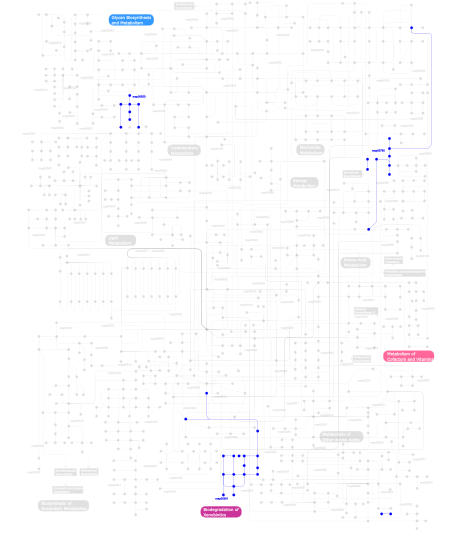alkPPcAlkaline phosphatase homologues |
|---|
| SMART accession number: | SM00098 |
|---|---|
| Description: | - |
| Interpro abstract (IPR001952): | This entry represents alkaline phosphatases ( EC 3.1.3.1 ) (ALP), which act as non-specific phosphomonoesterases to hydrolyse phosphate esters, optimally at high pH. The reaction mechanism involves the attack of a serine alkoxide on a phosphorus of the substrate to form a transient covalent enzyme-phosphate complex, followed by the hydrolysis of the serine phosphate. Alkaline phosphatases are found in all kingdoms of life, with the exception of some plants. Alkaline phosphatases are metalloenzymes that exist as a dimer, each monomer binding metal ions. The metal ions they carry can differ, although zinc and magnesium are the most common. For example, Escherichia coli alkaline phosphatase (encoded by phoA) requires the presence of two zinc ions bound at the M1 and M2 metal sites, and one magnesium ion bound at the M3 site [ (PUBMED:15938627) ]. However, alkaline phosphatases from Thermotoga maritima and Bacillus subtilis require cobalt for maximal activity [ (PUBMED:11910033) ]. In mammals, there are four alkaline phosphatase isozymes: placental, placental-like (germ cell), intestinal and tissue-nonspecific (liver/bone/kidney). All four isozymes are anchored to the outer surface of the plasma membrane by a covalently attached glycosylphosphatidylinositol (GPI) anchor [ (PUBMED:17520090) ]. Human alkaline phosphatases have four metal binding sites: two for zinc, one for magnesium, and one for calcium ion. Placental alkaline phosphatase (ALPP or PLAP) is highly polymorphic, with at least three common alleles [ (PUBMED:11124260) ]. Its activity is down-regulated by a number of effectors such as l-phenylalanine, 5'-AMP, and by p-nitrophenyl-phosphonate (PNPPate) [ (PUBMED:15946677) ]. The placental-like isozyme (ALPPL or PLAP-like) is elevated in germ cell tumours. The intestinal isozyme (ALPI or IAP) has the ability to detoxify lipopolysaccharide and prevent bacterial invasion across the gut mucosal barrier [ (PUBMED:18292227) ]. The tissue-nonspecific isozyme (ALPL) is, and may play a role in skeletal mineralisation. Defects in ALPL are a cause of hypophosphatasia, including infantile-type (OMIM:241500), childhood-type (OMIM:241510) and adult-type (OMIM:146300). Hhypophosphatasia is an inherited metabolic bone disease characterised by defective skeletal mineralisation [ (PUBMED:17719863) ]. This entry also contains the related enzyme streptomycin-6-phosphate phosphatase ( EC 3.1.3.39 ) (encoded by strK) from Streptomyces species. This enzyme is involved in the synthesis of the antibiotic streptomycin, specifically cleaving both streptomycin-6-phosphate and, more slowly, streptomycin-3-phosphate [ (PUBMED:1654502) ]. |
| GO function: | phosphatase activity (GO:0016791) |
| Family alignment: |
There are 11753 alkPPc domains in 11636 proteins in SMART's nrdb database.
Click on the following links for more information.
- Evolution (species in which this domain is found)
- Disease (disease genes where sequence variants are found in this domain)
- Metabolism (metabolic pathways involving proteins which contain this domain)
- Structure (3D structures containing this domain)
- Links (links to other resources describing this domain)







































































